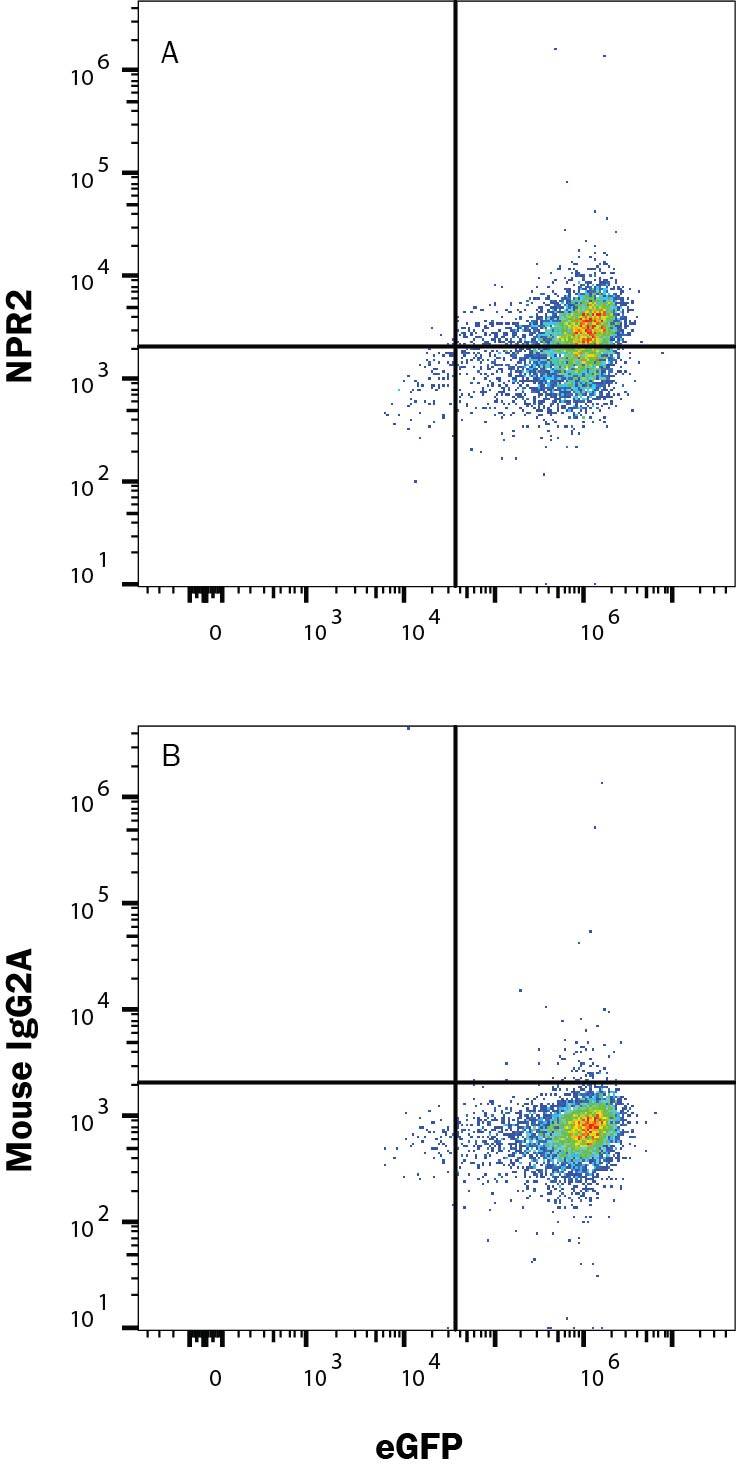Human NPRB/NPR2 Antibody
R&D Systems, part of Bio-Techne | Catalog # MAB9725


Conjugate
Catalog #
Key Product Details
Species Reactivity
Human
Applications
Flow Cytometry
Label
Unconjugated
Antibody Source
Monoclonal Mouse IgG2A Clone # 1060722
Product Specifications
Immunogen
Mouse myeloma cell line, NS0-derived human NPRB/NPR2
Arg23-Ile458
Accession # P20594
Arg23-Ile458
Accession # P20594
Specificity
Detects human NPRB/NPR2 in direct ELISA.
Clonality
Monoclonal
Host
Mouse
Isotype
IgG2A
Scientific Data Images for Human NPRB/NPR2 Antibody
Detection of NPRB/NPR2 in HEK293 cells transfected with Human NPR2 and eGFP by Flow Cytometry.
HEK293 cells transfected with Human NPR2 and eGFP were stained with either (A) Mouse Anti-Human NPRB/NPR2 Monoclonal Antibody (Catalog # MAB9725) or (B) Mouse IgG2A Isotype Control (Catalog # MAB003) followed by Allophycocyanin-conjugated Anti-Mouse IgG Secondary Antibody (Catalog # F0101B). View our protocol for Staining Membrane-associated Proteins.Applications for Human NPRB/NPR2 Antibody
Application
Recommended Usage
Flow Cytometry
0.25 µg/106 cells
Sample: HEK293 cells transfected with Human NPR2 and eGFP
Sample: HEK293 cells transfected with Human NPR2 and eGFP
Formulation, Preparation, and Storage
Purification
Protein A or G purified from cell culture supernatant
Reconstitution
Reconstitute at 0.5 mg/mL in sterile PBS. For liquid material, refer to CoA for concentration.
Formulation
Lyophilized from a 0.2 μm filtered solution in PBS with Trehalose. *Small pack size (SP) is supplied either lyophilized or as a 0.2 µm filtered solution in PBS.
Shipping
Lyophilized product is shipped at ambient temperature. Liquid small pack size (-SP) is shipped with polar packs. Upon receipt, store immediately at the temperature recommended below.
Stability & Storage
Use a manual defrost freezer and avoid repeated freeze-thaw cycles.
- 12 months from date of receipt, -20 to -70 °C as supplied.
- 1 month, 2 to 8 °C under sterile conditions after reconstitution.
- 6 months, -20 to -70 °C under sterile conditions after reconstitution.
Background: NPRB/NPR2
References
- Potter, L.R. et al. (2009) Handb Exp Pharmacol 191:341.
- Chang, M.S. et al. (1989) Nature 341:68.
- Tsuji, T. and Kunieda T. (2005) J Biol Chem 280:14288.
- Olney, R.C. et al. (2006) J Clin Endocrinol Metab 91:1229.
Long Name
Natriuretic Peptide Receptor B
Alternate Names
AMDM, ANPb, ANPRB, ECDM, GC-B, GUC2B, NPR2, NPRBi, SNSK
Gene Symbol
NPR2
UniProt
Additional NPRB/NPR2 Products
Product Documents for Human NPRB/NPR2 Antibody
Product Specific Notices for Human NPRB/NPR2 Antibody
For research use only
